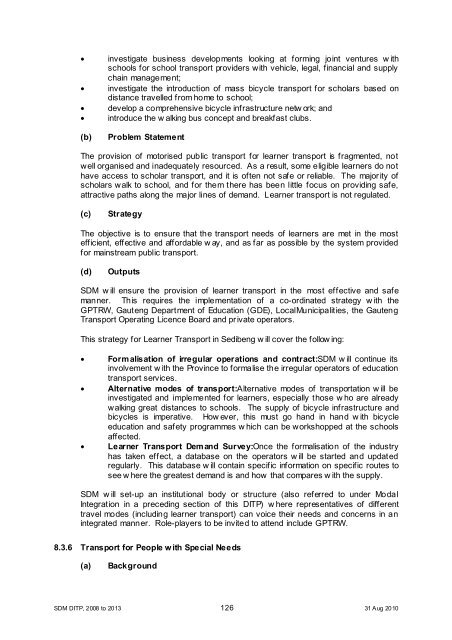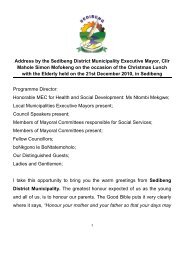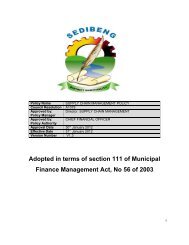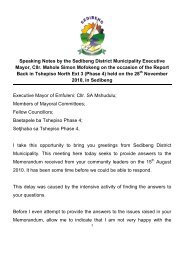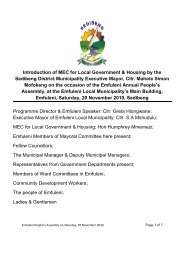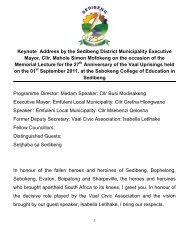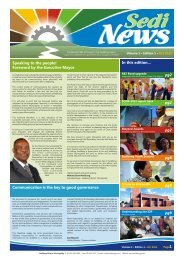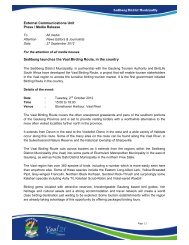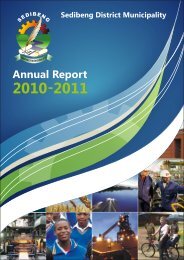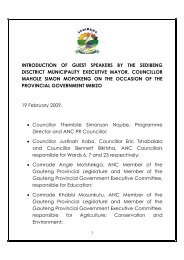Chapter 11 - Sedibeng District Municipality
Chapter 11 - Sedibeng District Municipality
Chapter 11 - Sedibeng District Municipality
Create successful ePaper yourself
Turn your PDF publications into a flip-book with our unique Google optimized e-Paper software.
• investigate business developments looking at forming joint ventures w ith<br />
schools for school transport providers with vehicle, legal, financial and supply<br />
chain management;<br />
• investigate the introduction of mass bicycle transport for scholars based on<br />
distance travelled from home to school;<br />
• develop a comprehensive bicycle infrastructure netw ork; and<br />
• introduce the w alking bus concept and breakfast clubs.<br />
(b)<br />
Problem Statement<br />
The provision of motorised public transport for learner transport is fragmented, not<br />
well organised and inadequately resourced. As a result, some eligible learners do not<br />
have access to scholar transport, and it is often not safe or reliable. The majority of<br />
scholars walk to school, and for them there has been little focus on providing safe,<br />
attractive paths along the major lines of demand. Learner transport is not regulated.<br />
(c)<br />
Strategy<br />
The objective is to ensure that the transport needs of learners are met in the most<br />
efficient, effective and affordable w ay, and as far as possible by the system provided<br />
for mainstream public transport.<br />
(d)<br />
Outputs<br />
SDM w ill ensure the provision of learner transport in the most effective and safe<br />
manner. This requires the implementation of a co-ordinated strategy w ith the<br />
GPTRW, Gauteng Department of Education (GDE), LocalMunicipalities, the Gauteng<br />
Transport Operating Licence Board and private operators.<br />
This strategy for Learner Transport in <strong>Sedibeng</strong> w ill cover the follow ing:<br />
• Formalisation of irregular operations and contract:SDM w ill continue its<br />
involvement w ith the Province to formalise the irregular operators of education<br />
transport services.<br />
• Alternative modes of transport:Alternative modes of transportation w ill be<br />
investigated and implemented for learners, especially those w ho are already<br />
walking great distances to schools. The supply of bicycle infrastructure and<br />
bicycles is imperative. How ever, this must go hand in hand w ith bicycle<br />
education and safety programmes w hich can be workshopped at the schools<br />
affected.<br />
• Learner Transport Demand Survey:Once the formalisation of the industry<br />
has taken effect, a database on the operators w ill be started and updated<br />
regularly. This database w ill contain specific information on specific routes to<br />
see w here the greatest demand is and how that compares w ith the supply.<br />
SDM w ill set-up an institutional body or structure (also referred to under Modal<br />
Integration in a preceding section of this DITP) w here representatives of different<br />
travel modes (including learner transport) can voice their needs and concerns in an<br />
integrated manner. Role-players to be invited to attend include GPTRW.<br />
8.3.6 Transport for People w ith Special Needs<br />
(a)<br />
Background<br />
SDM DITP, 2008 to 2013 126 31 Aug 2010


